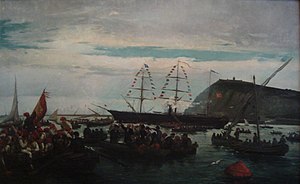La Demajagua (memorial)
| Ten Years' War | |||||||
|---|---|---|---|---|---|---|---|
 Painting: Embarkation of the Catalan Volunteers from the Port of Barcelona |
|||||||
|
|||||||
| Belligerents | |||||||
|
|
|
||||||
| Commanders and leaders | |||||||
|
|
|
||||||
| Strength | |||||||
| 12,000 rebels, 40,000 supporters | 100,000 | ||||||
| Casualties and losses | |||||||
| 300,000+ rebels and civilians | Unknown | ||||||
The Ten Years' War (Spanish: Guerra de los Diez Años) (1868–1878), also known as the Great War (Guerra Grande) and the War of '68, was part of Cuba's fight for independence from Spain. The uprising was led by Cuban-born planters and other wealthy natives. On October 10, 1868 sugar mill owner Carlos Manuel de Céspedes and his followers proclaimed independence, beginning the conflict. This was the first of three liberation wars that Cuba fought against Spain, the other two being the Little War (1879–1880) and the Cuban War of Independence (1895–1898). The final three months of the last conflict escalated with United States involvement and has become known also as the Spanish–American War.
Throughout the 1850s and into the 1860s, Cuban planters and business owners demanded fundamental social and economic reforms from Spain, which ruled the colony. Lax enforcement of the slave trade ban had resulted in a dramatic increase in imports of Africans, estimated at 90,000 slaves from 1856 to 1860. This occurred despite a strong abolitionist movement on the island, and rising costs among the slave-holding planters in the east. New technologies and farming techniques made large numbers of slaves unnecessary and prohibitively expensive. In the economic crisis of 1857 many businesses failed, including many sugar plantations and sugar refineries. The abolitionist cause gained strength, favoring a gradual emancipation of slaves with financial compensation from Spain for slaveholders. Additionally, some planters preferred hiring Chinese immigrants as indentured workers and in anticipation of ending slavery. Before the 1870s, more than 125,000 were recruited to Cuba. In May 1865, Cuban creole elites placed four demands upon the Spanish Parliament: tariff reform, Cuban representation in Parliament, judicial equality with Spaniards, and full enforcement of the slave trade ban.
The Spanish Parliament at the time was changing; gaining much influence were reactionary, traditionalist politicians who intended to eliminate all liberal reforms. The power of military tribunals was increased; the colonial government imposed a six percent tax increase on the Cuban planters and businesses. Additionally, all political opposition and the press were silenced. Dissatisfaction in Cuba spread on a massive scale as the mechanisms to express it were restricted. This discontent was particularly felt by the powerful planters and hacienda owners in Eastern Cuba.
...
Wikipedia
